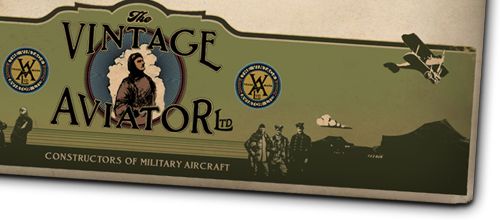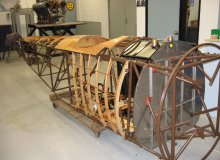Sopwith Triplane Replica Build Gallery
You are here
Sopwith Triplane History
“In early 1916, the Sopwith Experimental Department under the Sopwith Aviation Company decided to build an entirely new design: a triplane.”
Triplanes had been planned and designed pre WWI, but the new Sopwith became the first triplane fighter to be made and put into action. Several Sopwith triplane types were produced, but only one became mass-produced and this plane alone cemented its name in the history of the first great air war.
The Design
The first prototype was passed by the Experimental Department on May 28 1916, shortly after the Sopwith Pup had been approved which also coincided with the actual day the Pup flew its first flight to France. That this new and very different plane was completed in such a short space of time was no small achievement, especially considering the radical changes made to its design and configuration. For a single-seat fighter, the Triplane derived its rudimentary fuselage geometry and minor fittings from the Pup. It also included the same tail unit but with an adjustable tailplane. Although the wing span was the same as the Pup (26ft. 6 in.) the Triplane had a smaller wing area and its structure weight was greater, thus needing a more powerful engine in the 110-hp Clerget 9Z. The Triplane was armed, like the Pup with a single mounted synchronised Vickers gun.
Structurally, the Triplane was a bold and ingenious creation, with its three narrow-chord wings all of which were fitted with ailerons and plain but strong interplane struts that needed few bracing wires. The most desirable features of the Triplane were
however, its increased field of vision for the pilot, its maneuverability and harmonised controls. For greater performance, the 110-hp Clerget 9Z engine was later replaced by the 130-hp Clerget 9B Rotary.
Service
The first prototype Triplane, serial N500 was flown by Sopwith test-pilot Harry Hawker who dazzled those present by looping the aircraft three times within minutes of take off. The Triplane was then sent to France in mid 1916 to undergo service trials with the Naval A Fighting Squadron at Furnes. The plane was an instant success with pilots and servicemen and apparently, was sent up on an interception mission within a quarter of an hour of its arrival in Furnes. Ordered exclusively for the RNAS, the Triplane was soon put into production for the RFC. In immediate action, the Triplane had a marked advantage over the Albatros DIII. The Sopwith could out-climb and out-turn plus it was at least 15 mph faster.
The Germans received a huge shock at the arrival of this new model fighter aircraft and it sent them into a brief Triplane-making frenzy. No less than 34 prototype Triplanes were produced by German and Austrian manufacturers by the end of the war. With a successful combat debut, the Triplane became famously flown by No. 10 Naval Squadron’s “B Flight”, better known as “Black Flight”. In three months, Black Flight claimed 87 German aircraft, 33 of which were claimed by their commander, Ace-Pilot Raymond Collishaw. For several reasons, the Triplane’s combat career was relatively brief. The Triplane proved difficult to repair and the fuel and oil tanks were inaccessible without major disassembly of the wings and fuselage. During service, spare parts became increasingly difficult to obtain and the RNAS began to reduce their numbers of the aircraft.
Structural weakness also became an issue with the Triplane as its wings sometimes collapsed in steep dives and this - coupled with its single Vickers gun led to mixed results with armourment modifications and structural experiments. Seeing that roughly only 150 Sopwith Triplanes were ever built during WWI, it is surprising how much they impacted on the war with their trend of design and service statistics.
Specifications
General Characteristics
Crew: 1
Length: 18 ft 10 in (5.73m)
Wingspan: 26 ft 6 in (8m)
Height: 10 ft 6 in (3.2)
Wing Area: 231 ft (21.46m)
Empty Weight: 993lb (450 kg)
Loaded Weight: 1,415lb (642 kg)
Powerplant: 1 X Clerget 9B Rotary Engine, 130hp (96kw)
Performance
Maximum Speed: 117 mph at 5,000 ft. (187 km/hr at 1,830 m)
Range: 280 m (450 km)
Service Ceiling: 20,500 ft (6,250 m)
Wing Loading: 6.13 lb/ft (29.92kg/m)
Endurance: 2 hrs 45 min.
Time to altitude: 6.33 min to 6,500 ft (1,980 m)
Harry Hawker
Harry George Hawker MBE, AFC was an Australian aviation pioneer and co-founder of the Hawker Aircraft. He was a founding member of the firm that later became responsible for creating a long series of successful fighter aircraft, including the Fury, Sea Fury, Hunter, Harrier and Hurricane. Born in Victoria, Australia in January 1889, Hawker began as a mechanic building engines and cars for the Tarrant Motor and Engineering Co. In 1912 he moved to England and joined the Commer Car Company and then the Sopwith Aviation Company. Becoming immersed in aviation, Hawker began instructing novice flyers and managing hangars at Brooklands Aerodome, the hub of British aviation. Hawker eventually became chief test pilot for Tom Sopwith who was already famous as the originator of many types of aircraft. Hawker had much involvement in the development and testing of the Sopwith Pup and later the Sopwith Triplane during WWI.
In 1920, Sopwith Aviation was liquidated to escape a massive retrospective tax liability that they feared the Government would impose on them for wartime production contracts. Along with Tom Sopwith, Hawker then started up a new company which at first called H.G Hawker and then posthumously Hawker Aircraft. Harry Hawker died in 1921 whilst flying an experimental aircraft, practising for an airshow.



